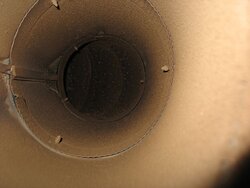I had never heard of such a practice until I joined this site. I always figured the joints in stove pipe sealed tight enough on their own and I couldn't justify sealing them w/ cement just to have to break it apart and redo it w/ the mess at each cleaning.
Tonight however I started thinking otherwise. I've got a small fire going to take the chill off and am sitting here at the computer about 15 feet away when I can hear this air leaking noise. I go over and for the first time I can hear air being sucked into the joints!
And to answer your question, no, I was not having a chimney fire. I just installed a new 6 in liner in my chimney that I insulated. I think the liner has improved my draft enough that it actually is sucking hard enough to pull air in there now.
This then is why I ask, who actually does this practice? What are your thoughts on it? How much of a mess does it make doing it. Does it make a difference in creosote build up in the pipes? etc. etc.
pen
Tonight however I started thinking otherwise. I've got a small fire going to take the chill off and am sitting here at the computer about 15 feet away when I can hear this air leaking noise. I go over and for the first time I can hear air being sucked into the joints!
And to answer your question, no, I was not having a chimney fire. I just installed a new 6 in liner in my chimney that I insulated. I think the liner has improved my draft enough that it actually is sucking hard enough to pull air in there now.
This then is why I ask, who actually does this practice? What are your thoughts on it? How much of a mess does it make doing it. Does it make a difference in creosote build up in the pipes? etc. etc.
pen


